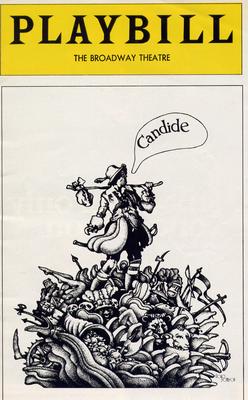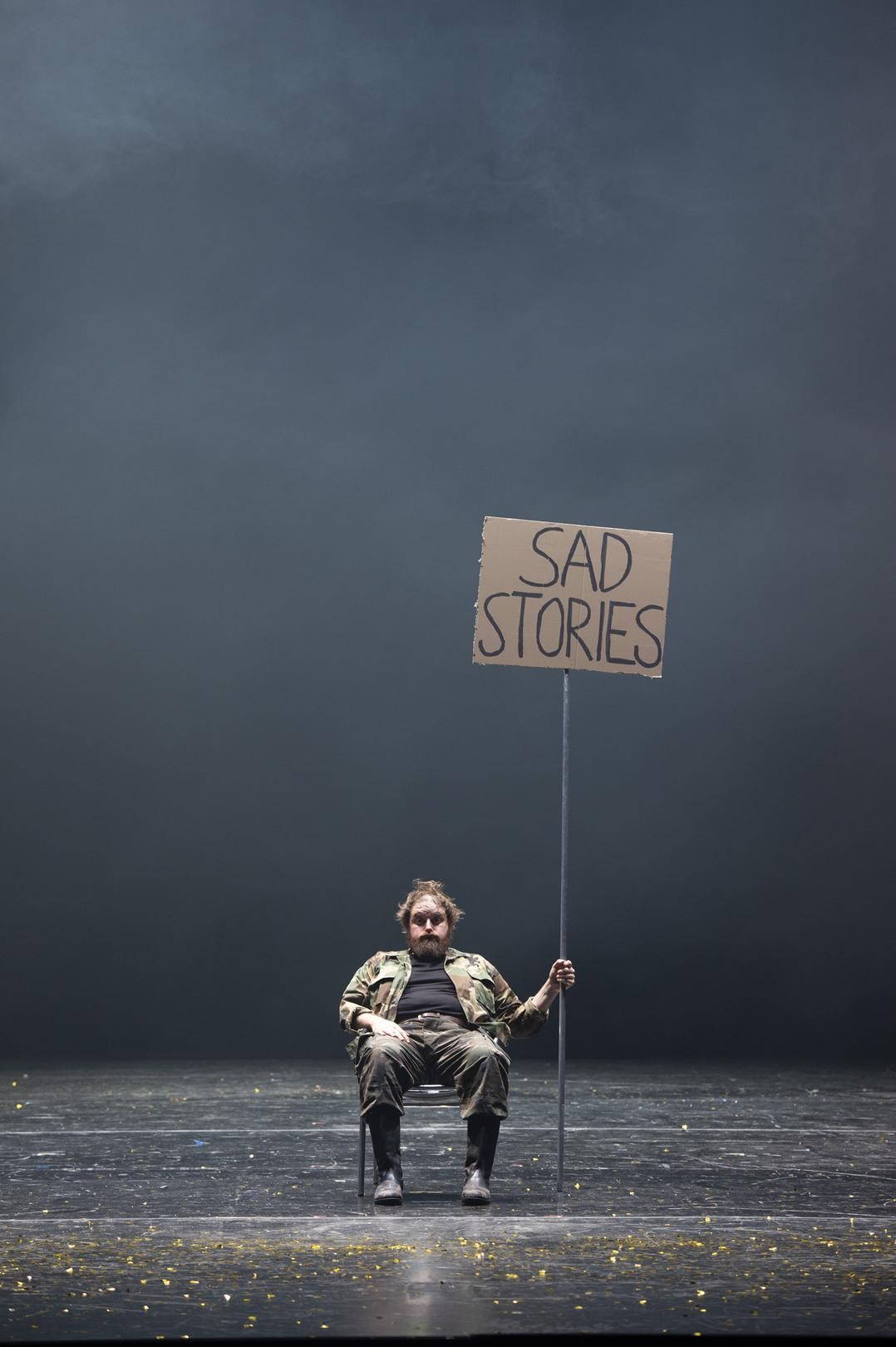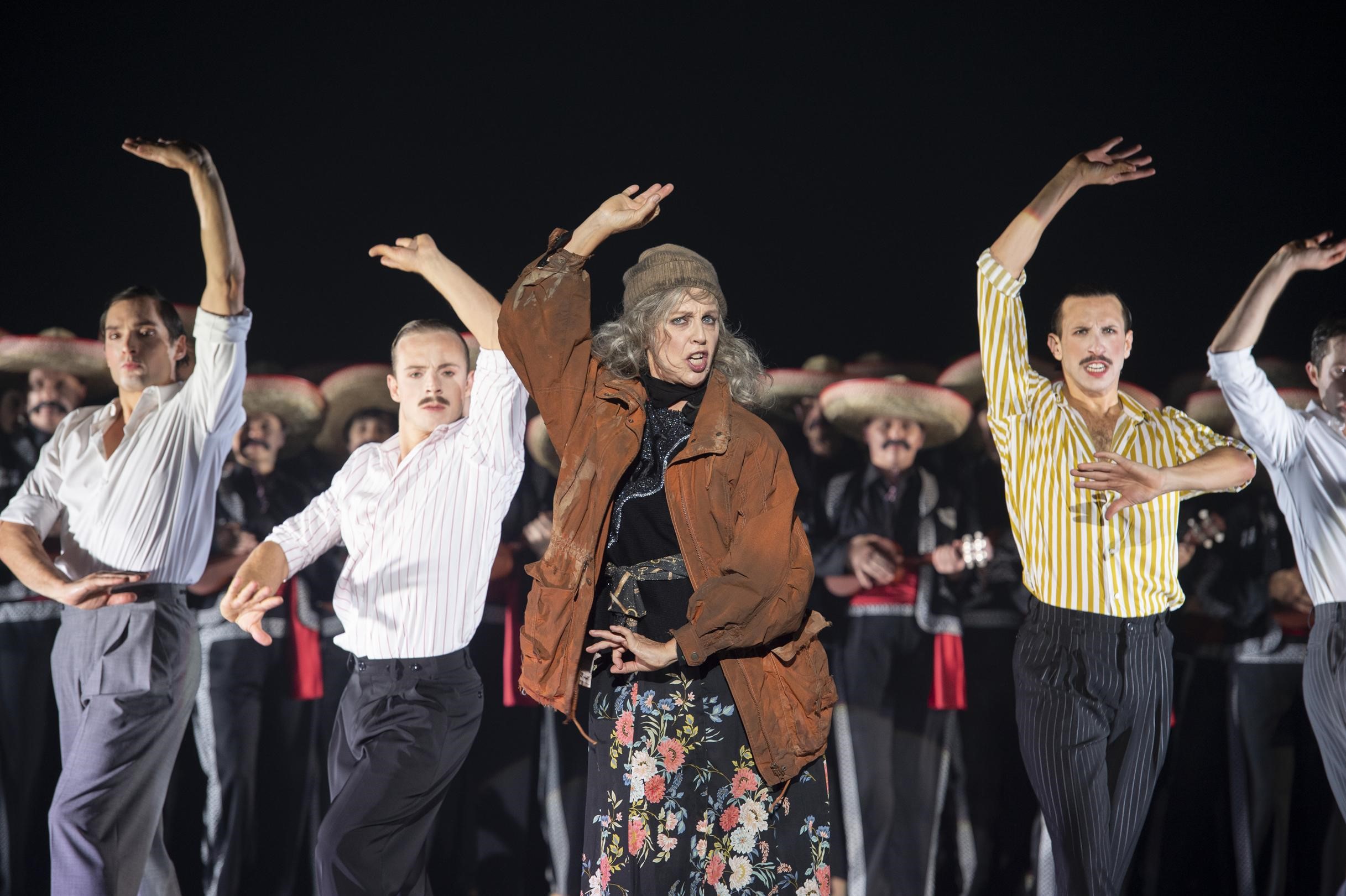David Savran
Operetta Research Center
17 March, 2019
Imagine a world that persistently rewards the rich and powerful while immiserating the masses. Imagine an international paternalist cartel that scapegoats minorities and refugees, while treating women like chattel to be bought, coddled, and dumped. Voltaire did so in his 1759 novella Candide by simply observing—and ruthlessly satirizing—the world around him. Leonard Bernstein and his collaborators did so two centuries later in their notorious flop. Sixty years on, Barrie Kosky has followed suit and succeeded rapturously in resurrecting Candide by underscoring both its historicity and its disturbing contemporaneity.

The original 1956 cast album of “Candide.” (Photo: Columbia Records)
Leonard Bernstein’s Candide (1956) is a puzzling piece. Its Broadway premiere garnered famously mixed reviews and the piece continues to have its supporters and detractors. Its plot is as impudently peripatetic as its protagonists and its wildly eclectic score ranges in style from bubbling musical comedy charm song to coloratura aria, Spanish dance to Mahlerian cri de coeur. Despite the firmament of starry names associated with the piece, it has been radically revised more often than any other musical.[1] At least seven different libretti follow in the wake of Lillian Hellman’s much-disparaged original and only once has it enjoyed a long run in the theatre, in Harold Prince’s 1973 musically stripped down, environmental staging.

Playbill for the 1973 version of Leonard Bernstein’s “Candide,” directed by Harold Prince.
Hugh Wheeler’s frothy book for Prince (Hellman withdrew the performance rights to her script) has been criticized by conductor John Mauceri as being “one long joke” from which the original’s “heart, . . . tears, and . . . faith” were stripped.[2] Yet Wheeler’s rewrite has become the jumping off point for all subsequent revivals and adaptations, which as a rule keep moving the piece closer and closer back to Voltaire’s original. Although seven lyricists are credited with the lyrics, the lion’s share is by Richard Wilbur.
Harold Prince’s Broadway production, like many others, streamlined Candide’s emotional and musical scale and emphasized its farcical elements at the expense of Voltaire’s penchant (in Bernstein’s words) for “throw[ing] light on all the dark places.”[3] Bernstein and Hellman were drawn to the novella for its caustic satire of Leibnizian (and, in their view, Eisenhowerian) optimism and of Spanish Inquisition-style (and McCarthyist) witch hunts. Their Candide, like Voltaire’s, thus depicts anything but the best of all possible worlds. Bernstein and Hellman were committed leftists who had been persecuted during the anti-communist witch hunt of the early 1950s and both were intent on using Candide as artistic revenge. Although Hellman was accused of “wield[ing] the text as too blunt an instrument of social critique,”[4] Candide retained (and continues to retain) its satirical attack on political tyranny, militarism, ideological straitjacketing, materialism, and colonialism.
Despite Bernstein’s championing of “American musical comedy” during the 1950s,[5] Candide is plainly a satire of European operetta, which, dating back to the nineteenth century, has always been the most satirical of musical theatre genres. But it is very much a Broadway-style operetta whose inventive, ambitious score places it in line with the other genre-stretching musicals of the 1950s.[6] With its considerable musical demands, Candide is usually encountered these days in opera houses. And given the density of opera houses in the German-speaking world, one is much more likely to see it there (where it was not premiered until 1976 but has since established itself on the fringe of the standard repertoire) than elsewhere. Candide’s first act follows the characters from Westphalia to their embarkation for the New World and, in most versions, works effectively in the theatre. In contrast, Candide’s second act is often regarded as scattershot and digressive, coming into focus only belatedly in its radiant finale, “Make Our Garden Grow.”
The theatrical dynamism of Bernstein’s Candide lies in the violent contradiction between the ravishing beauty and wit of its score and lyrics and the relentless succession of horrors that comprises its plot. (Stephen Sondheim considers it to have “the most scintillating set of songs yet written for the musical theater.”)[7] This contradiction is not a flaw; rather it is the crux of the piece’s unique brilliance and power. I quote at length Raymond Knapp’s litany of the “most horrifying realities” that Voltaire’s Candide exploits to emphasize the operetta’s uniquely schizophrenic logic. These realities include
devastating natural disasters (earthquakes, fires, storms at sea, and the like), the plague, syphilis, war (including forced conscription, multiple rape, dismemberment, and other brutalities), slavery (including multiple rape, punitive dismemberment, and other brutalities), piracy (including rape, dismemberment, and other brutalities), partial cannibalism, . . . public torture and execution, murder, . . . religious conflict and persecution, racial conflict and persecution, class-based exploitation, political corruption, prostitution and other more direct forms of sexual slavery, . . . avarice leading to thievery and swindles, power lust, blackmail and extortion, ignorance, . . . and everyday cruelties such as poverty, hunger, the repayment of kindness with betrayal, and a general lack of human charity toward those who suffer. If this seems a grim list, it is nevertheless by no means complete, for Voltaire’s Candide is unrelenting in its detailed parade of human misery. It is, in fact, one of the most unpleasant classic texts available, invaluable for its critique of a time that others insisted on seeing more positively, yet for the most part expressing no credible hope for its embattled cohort of characters whose sufferings are elaborated as the core of nearly every episode.[8]

Allan Clayton in “Candide” at Komische Oper Berlin, directed by Barrie Kosky. (Photo: Monika Ritterhaus)
How is a director to stage the violent contradiction between such a jarringly “unpleasant” plot and such a dazzling score? A realistic production being unthinkable, most directors choose to emphasize the farcical, fantastical nature of Candide’s brutalities and the two-dimensionality of its protagonists. Barrie Kosky does as well, but by radicalizing the clash between the sublime and the ridiculous, he turns it into what he calls an “existential vaudeville” that takes Candide’s sparkling comedy seriously by mining it for tragedy.[9] For all its silliness, Kosky’s Candide disproves Leibnizian optimism by depicting the realest of all possible worlds as a merry-go-round of exploitation, greed, and slaughter. By underscoring this message, Kosky’s staging (based on John Caird’s 1999 version for the Royal National Theatre) mines the intriguing parallels between Bernstein’s operetta and two plays that took the world by storm during the decade of Candide’s launch, Samuel Beckett’s Waiting for Godot and Endgame. Like Beckett’s plays, Kosky’s new production spotlights and honors Candide’s absurdist logic as the inexorable law of a ruthlessly arbitrary and devastatingly unjust world. Like them, it employs classic vaudeville turns while reframing and darkening them. In recognizing the piece’s kinship with its absurdist contemporaries, this production exposes the philosophical fatalism that underlay the post-World War II boom years and simultaneously illuminates the darkest corners of our own world.
Despite the existential gloom into which Kosky’s protagonists descend, his mise en scène is anything but solemn. Rather, his strategy reminds me of Bert States’s description of Waiting for Godot, which, according to States, “offers a collision of the essentially pure energies of comedy and tragedy.”[10] Delighting in the piece’s “musical schizophrenia,”[11] Kosky stages it as a rowdy, carnivalesque, vaudevillian banquet (performed in Martin G. Berger’s new German translation), idiomatically and affectionately conducted by Jordan de Souza. Using movable set pieces (designed by Rebecca Ringst) and flashy costumes (by Klaus Bruns) that run the gamut from faux eighteenth-century to Las Vegas showgirl, faux folkloric to contemporary street dress, Kosky engineers a gaudy spectacle. The stage is lit by Alessandro Carletti, whose sharp beams of white light pierce the often smoke-filled space, and the eye-popping choreography is by Otto Pichler, Kosky’s usual collaborator. The dancers work overtime in this lavish production and even Cunegonde’s showstopping “Glitter and Be Gay” is staged as a flashy pole dance in a Paris dive which Cunegonde (Nicole Chevalier), surrounded by women dancers, deftly negotiates while warbling this coloratura tour de force.
Perhaps the score’s most elaborate number dramatically is the Lisbon “Auto-da-fé,” in which the chorus’ merry celebration is intermittently interrupted by a series of summary trials and executions.
What a day, what a day
For an auto-da-fé!
It’s a lovely day for drinking
And for watching people fry!
In Kosky’s staging, the auto-da-fé is an unmistakably contemporary media event, complete with cameras and boom microphones, that climaxes in the hanging of Pangloss and the flogging of Candide. The throngs of merrymakers are joined by a chorus line of leggy, can-canning show “girls” in Vegas-style bright blue and white one-pieces, with oversized feather headdresses and trains (typically for a Kosky/Pichler production, both women and men dance as scantily-clad chorus “girls”). The trial and punishment of Pangloss and Candide is preceded by two others, the first of two cartoonish Orthodox Jews and the second of a refugee couple carrying plastic tote bags (the woman wears a burqa).[12] Both pairs are nonchalantly condemned and machine-gunned, then hastily dragged off-stage by the show “girls.” The clangorous dissonance between the giddy song and dance and the tragic interruptions intensifies Bernstein’s musical contrast between the chorus’ allegro giocoso and the Inquisitors’ dirge-like chant.
Kosky’s pair of unmistakably contemporary refugees is but one of many examples of the renewed relevance that his Candide contrives. The first act closes with Candide and company (along with the chorus) escaping to the New World in three large rubber dinghies that clearly evoke the leaky, makeshift barks that refugees are forced to take fleeing from North Africa to Europe. In Surinam, Candide’s servant Martin, “the most wretched, pessimistic person [Candide] could find,”[13] is re-gendered as a woman-played-by-a-man street-sweeper in the tradition of the scene-stealing travesty roles of Monteverdi or Cavalli. Martin’s carnivalesque drag (as working-class executor of feminized labor) gives his misanthropy a fascinatingly grotesque and wonderfully theatrical twist. Indeed, Tom Erik Lie’s fastidiously measured delivery of Martin’s spoken invective against an insidious God (and the wretched planet he created) becomes one of the highlights of the show:
Wenn ich auf diese Erdkugel schaue—oder vielleicht eher auf dieses Kügelchen—kann ich nicht anders als zu denken, dass Gott sie irgendeiner heimtückischen Macht überlassen hat. Ich kenne keine Stadt, die nicht den Untergang ihrer Nachbarschaft gewünscht hätte, keine Familie, die nicht eine andere Familie hätte ausrotten wollen. Die Armen hassen die Reichen und doch kriechen und buckeln sie vor ihnen. Die Reichen behandeln die Armen wie eine Schafsherde, deren Fleisch und Wolle man verschachern kann …
Ihr fragt euch vielleicht: Waren die Menschen schon immer so? Immer schon Lügner, Betrüger, Heuchler, Verräter, Diebe, Neider und Banditen? Werden sie denn immer feige sein, missgünstig, eitel, überambitioniert, schwach, launisch, gefräßig, trinksüchtig, wollüstig, gierig, geizig, blutrünstig, verleumderisch, unsittlich, fanatisch, grausam, verlogen und dumm?[14]
As amusing as this tirade (closely modelled on Voltaire) may be, the only pessimist in the piece provides a much more accurate characterization of the world onstage (and off!) than Pangloss’s fraudulent platitudes.

Anne Sofie von Otter as The Old Lady in Barrie Kosky’s “Candide” at Komische Oper Berlin. (Photo: Monika Ritterhaus)
The second act of Kosky’s Candide bears witness to the slow unravelling of optimism and hope. Martin’s remarkable disquisition on misery is one of three moments in the staging that bring the existentialist subtext to the surface. As narrator, Voltaire/Pangloss (Franz Hawlata) sets the scene, and through the second act, his litany of new locales—Montevideo, Surinam, Marseilles, Venice—is each time greeted by Candide’s befuddled question, “Warum [the next venue on his seemingly arbitrary itinerary]?” Voltaire’s reply is always, “Warum nicht?” With each iteration, however, Hawlata’s reply becomes more exasperated. His final “Warum nicht?” is almost spit out, sounding less the innocent rhetorical question than the threat of a sadistic author/creator.
For all Candide’s trials and tribulations, it is questionable whether Voltaire’s protagonist ends his journey an enlightened man. Bernstein’s hero, however, especially in later editions of Candide (including his own recording), is given a moment of illumination, an elegiac aria “Nothing More Than This” that follows his ridiculously overdue acknowledgment of Cunegonde’s venality. Especially as performed by Paul Curievici, however, this aria had resonances that reached far beyond Cunegonde’s betrayal. In his performance, this plaint (with lyrics by Bernstein) became a bitter rejection of Pangloss’s irresponsible optimism and a tragic acknowledgment of the precarity and evanescence of earthly things.
Like Bernstein, Kosky does not end Candide in disgust or resignation. Rather, his staging of the social collective in the final number squarely addresses the contemporary world of which we are all citizens. This world, moreover, is represented literally in Kosky’s production by the repeated appearance of characters carrying small globes (including five penitent kings and queens in the Venice sequence singing the haunting “King’s Barcarolle”). When Voltaire is revealed at the top of the show, wearing a gargantuan wig, he is carrying a globe. During the opening scene in the Westphalian schoolhouse, a large colored map of the world (circa 2018) hangs on the back wall bearing the legend: DIE ERDE, KLIMAZONEN. Just before the final number, a huge inflated globe appears upstage and slowly rolls toward the audience, only to be intercepted by Candide and Cunegunde and then hoisted aloft and slowly spun by the chorus. The presence of this miniature earth gives a new meaning and urgency to one of the most resplendent finales in all music theatre. “This is our world,” it seems to say, “now threatened by man-made apocalypse. Guard it well, protect it, make our garden grow.”
Preferring an admonitory finale to a happy romantic one, Kosky recognizes that at the end of their travels, when Candide and Cunegonde finally confront each other, “wenn sie am Ende wieder aufeinander treffen, sind sie sich vor allem eins: fremd.”[15] The meaning of this sentence is complicated by the fact that the German word, fremd, has no equivalent in English. It means alien, strange, unfamiliar, unknowable; but also foreign. And it is precisely this foreignness in which Kosky’s Candide basks: the foreignness of Bernstein’s utterly Americanized operetta in the genre’s homeland; and the foreignness of this production’s glitzy, Las Vegas-style turns in an opera house.

Allan Clayton with dancers in “Candide” at Komische Oper Berlin, directed by Barrie Kosky. (Photo: Monika Ritterhaus)
In an otherwise favorable review in the Frankfurter Allgemeine, a bastion of German high culture, Christiane Tewinkel ends her review by noting the surprising foreignness of Kosky’s Candide at the Komische Oper: “Selten sah man den Geist des Friedrichstadtpalastes mit solcher Verve in ein Opernhaus einziehen.”[16] Referencing the Berlin temple to overstuffed, over-sequined musical revues, Tewinkel betrays, I believe, a certain condescension in regard to Kosky’s wildly lavish production of Bernstein’s masterpiece. Such splendor, Broadway-style extravagance, and creativity are indeed uncommon in the high-pressure (but well-funded) world of German opera. What was perhaps less apparent to her (and to other German critics) was the ingenious way that Kosky translates a quintessentially U.S.-American Cold War liberal protest against tyranny into a spectacular reflection on the state of the planet and the human species, which, sixty-some years after Candide’s premiere, has become far more endangered and precarious than Bernstein could then have imagined.
For more information and performance dates of Barrie Kosky’s production, click here.
[1] I make this claim with some trepidation although the only other musical that would seem to be in serious running for this dubious honor is Show Boat, which has also been completely revised many times, although over many more years and for completely different reasons.
[2] John Mauceri, “Candide or No Exit,” from the program of the 1988 Scottish Opera Production.
[3] Leonard Bernstein, “Colloquy in Boston,” New York Times, 18 November 1956, 133.
[4] Elizabeth B. Crist, “The Best of All Possible Worlds: The Eldorado Episode in Leonard Bernstein’s Candide,” Cambridge Opera Journal, Vol. 19, No. 3 (November 2007), 227.
[5] Bernstein, “Colloquy in Boston.”
[6] I am thinking, for example, of Rodgers and Hammerstein’s The King and I (1951), Wright and Forrest’s Kismet (1953), Jerome Moross’s The Golden Apple (1954), Frank Loesser’s The Most Happy Fella (1956), Bernstein’s own West Side Story (1957), and Marc Blitzstein’s Juno (1959).
[7] Stephen Sondheim, Finishing the Hat: Collected Lyrics (1954-1981) with Attendant Comments, Principles, Heresies, Grudges, Whines and Anecdotes (New York: Knopf, 2010), 324.
[8] Raymond Knapp, The American Musical and the Performance of Personal Identity (Princeton: Princeton University Press, 2006), 318.
[9] “Existentielles Vaudeville: Regisseur Barrie Kosky über musikalische Schizophrenie, Gartenarbeit und den Sinn des Leben” (Existential Vaudeville: Director Barrie Kosky on Musical Schizophrenia, Gardening, and the Meaning of Life”) Candide Program, Komische Oper Berlin, 2018, 15.
[10] Bert O. States, The Shape of Paradox: An Essay on Waiting for Godot (Berkeley: University of California Press, 1978), 61.
[11] “Existentielles Vaudeville,” 10.
[12] The wearing of burqas has sparked controversy, and often laws prohibiting it, throughout Europe, especially since the 2015 refugee crisis. See “The Islamic Veil Across Europe,” BBC News, May 31, 2018, https://www.bbc.com/news/world-europe-13038095 (accessed March 14, 2019).
[13] English Plot Summary, Candide Program, 39.
[14] Candide typescript, trans. Martin G. Berger.
[15]“Existentielles Vaudeville,” 12.
[16] Christiane Tewinkel, “Candide in Berlin: Weltverriss im Walzertakt,” Frankfurter Allgemeine Zeitung, 27 November 2018, https://www.faz.net/aktuell/feuilleton/buehne-und-konzert/bernsteins-candide-an-der-komischen-oper-in-berlin-15910560.html (accessed 10 January 2019).

Informative, enriching and altogether great writing.